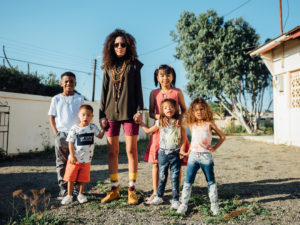Let’s say that to be able to complete a mission, you must join a circus. While doing so, however, you do not become a clown; you maintain your true character. But because you do not conform, you are able to observe what is taking place inside the circus and deem it chaotic. Those who conformed consider the environment to be the norm. Your ability to see the environment differently is caused by your commitment to remain true to your beliefs and values.
The poem is dedicated to the underlying realities that you are able to capture as you navigate the chaotic environment while being in camouflage. You may experience the use of certain tools for good and you may be exposed to the ways these are also used for evil. The first sentence of the poem can be considered a prayer dedicated to these tools: “Sumpiña saca spinia fo’i mi cara m’a laga mi pia na paz” (Thorn, remove the blackheads from my face but leave my feet alone).
Aside from these tools, there are the people on the inside and their behavior. There may be a hierarchy, an order, a way of living that everyone seems to obey without question, but because you are in camouflage, you are able to see what lies beneath the surface: “Ded’i pikiña su bisiña yena cu duda den mayor de todo/Ay caramba… galiña sin cabes no por stop di rondia” (Little finger and his neighbor are filled with doubt in the strongest of them all/Well, ain’t that something… the headless chicken cannot stop searching). These sentences are a play on the lyrics of a nursery rhyme. The nursery rhyme gives each of our fingers a name and after calling out their names, one by one, the nursery rhyme ends by repeating “galiña ta rondia neishi” (the chicken seeks her nest) several times. By giving insight into the relationship between these ‘fingers,’ I aim to add layers of information to where previously only their names were accessible. By turning the healthy chicken into a headless chicken, I justify her endless searching and do not blame her for being unable to find whatever she is looking for.
With this passage, I aim to express that those entering a chaotic environment in camouflage must exhibit compassion for those who do not know better. They must assume the responsibility that comes with being in camouflage, which is to influence others. If you manage to complete your mission and transform the chaotic environment, you can begin to trust your surroundings: “Kita bo tenchi sunu, si bo ta sigur” (Undress your toes, if you are sure), for if you succeed, the thorns will no longer be used for evil.
Camufla features on Datapanik’s latest album “Rayo di Tempo,” which was released in 2017. I was invited to feature on this track by lead singer Michael Lampe, an artist that I have admired for a long time. We have collaborated in the past, experimenting with his music and my poetry, including a 30-minute performance in Bogota, Colombia in 2016. However, this is the first track we have recorded and published. The video was shot by Jonathan Petit, a photographer and videographer with an artistic vision that inspires me greatly. We had been meaning to collaborate on a project for quite a while and Camufla came at the perfect time to put our heads together and create this video. Shout out to all those involved in making this happen. I am grateful for your love and patience.

